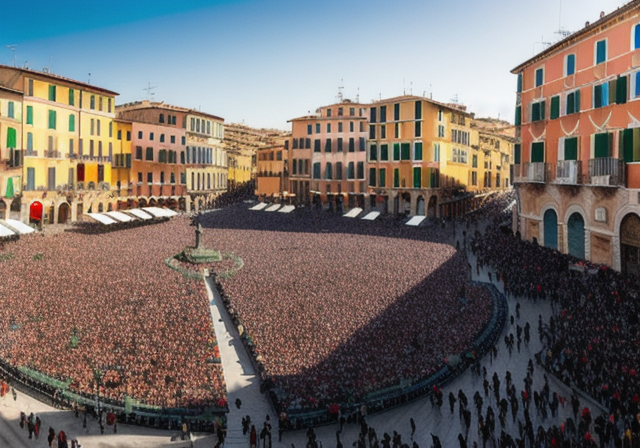Introduction
Overview of Political Participation in Italy
Political participation in Italy encompasses various forms of political engagement, including voting, protests, demonstrations, and joining political parties. Italians have a strong sense of civic duty, and political participation is seen as a way to shape the country’s future. One of the most significant ways Italians participate in politics is through voting. The right to vote was established in Italy in 1946, after the fall of Fascism. Voting is compulsory in Italy, and citizens who fail to show up to vote are subject to a fine.
Protests and demonstrations are also common forms of political participation in Italy. Italy has a long history of social movements, and protests have been instrumental in shaping the country’s policies. The country is famous for its lively and often colorful demonstrations, which often take place in public squares and streets. Joining political parties is another way Italians participate in politics. Italy has a multi-party system, with numerous political parties representing various interests and ideologies.
Brief History of Political Participation in Italy
The history of political participation in Italy dates back to the Risorgimento, the movement that led to the country’s unification in 1861. During this period, Italians participated in various forms of political activism, including protests and uprisings, to challenge the ruling powers. After the country’s unification, political participation continued to be a significant part of Italian life.
One of the most significant periods of political participation in Italy was the 1960s and 1970s, which saw a surge in social movements. The student movement of 1968 was a turning point in Italian politics, with students taking to the streets to protest against the government and challenge the status quo. The 1970s saw the rise of terrorism in Italy, with various extremist groups engaging in violent acts. The period was marked by political violence and turmoil, which ultimately led to a crackdown on extremist groups.
Today, political participation in Italy remains strong, with citizens engaging in various forms of political activism to shape the country’s future. From voting in elections to protesting in the streets, Italians continue to play an active role in the country’s political landscape.
Voting in Italy
Italy is a parliamentary republic, which means that the people elect their representatives through voting. To vote in Italy, you must be at least 18 years old, an Italian citizen, and registered with your local municipality. Additionally, you must not have any legal restrictions on your right to vote, such as being in prison or having been declared mentally incompetent by a court.
There are three types of elections in Italy: general elections, regional elections, and local elections. General elections are used to elect the members of the Chamber of Deputies and the Senate, while regional elections are used to elect the members of the regional councils. Local elections are used to elect the mayors and members of the city councils.
General Elections in Italy
General elections in Italy take place every five years. The two main political parties in Italy are the Democratic Party and the Five Star Movement. In addition to these main parties, there are several smaller parties that also participate in the elections.
The role of political parties in Italian elections is crucial. The parties are responsible for nominating candidates for the elections, and they also develop and promote their political platforms. Political parties also play an important role in forming coalitions, which are necessary to form a government in Italy.
Regional and Local Elections in Italy
Regional and local elections in Italy take place every five years. Unlike general elections, regional and local elections are not held on the same day throughout the country but are instead held on different dates depending on the region or municipality.
The voter turnout in recent elections in Italy has been relatively low, with less than 60% of eligible voters participating in the 2018 general election. However, the turnout is higher in regional and local elections, with some regions reporting a participation rate of around 70%.
Despite the low voter turnout, Italian politics is still lively and engaging. The country has a rich political history, and its citizens take their political participation seriously. If you are an Italian citizen, it is important to participate in the elections and make your voice heard.
Political Activism in Italy
Political activism in Italy has a long and rich history, dating back to the country’s unification in the 19th century. In recent years, political activism has been on the rise, with a growing number of Italians becoming involved in protests, demonstrations, and other forms of political engagement. The country has a diverse range of political movements, from left-wing groups advocating for workers’ rights and social justice to right-wing organizations calling for stronger national borders and immigration controls.
Types of Political Activism in Italy
One of the most common forms of political activism in Italy is street protests and demonstrations. These events can range from peaceful marches to violent clashes with police, and they often center around issues like labor rights, social inequality, and government corruption. Another popular form of activism is online advocacy, where Italians use social media platforms to share information, organize events, and mobilize support for political causes.
Trade unions also play an important role in political activism in Italy, with workers organizing strikes and other forms of protest to demand better working conditions and higher wages. Environmental activism is also on the rise, with a growing number of Italians calling for action on issues like climate change and pollution.
Recent Examples of Political Activism in Italy
One of the most high-profile examples of political activism in recent years was the “Sardines” movement, which emerged in 2019 in response to the rise of right-wing populist parties in Italy. The movement organized large-scale demonstrations across the country, calling for a more inclusive and tolerant society. Another notable example was the student-led protests in 2018, which saw thousands of young people take to the streets to demand action on climate change.
More recently, political activism in Italy has focused on the COVID-19 pandemic, with many Italians protesting against the government’s handling of the crisis. In November 2020, protesters clashed with police in Rome and other cities, calling for an end to lockdown measures and greater economic support for those affected by the pandemic.
The Impact of Political Activism on Italian Society
Political activism has had a significant impact on Italian society, shaping public opinion and influencing government policy. Many of Italy’s most important social and political reforms, such as the legalization of divorce and the introduction of same-sex civil unions, were achieved through grassroots activism and public pressure. Political activism has also helped to keep issues like corruption and social inequality on the political agenda, forcing politicians to take action and address these problems.
However, political activism in Italy is not without its challenges. The country’s complex political landscape and history of corruption can make it difficult to achieve meaningful change, and many activists face resistance from those in power. Nevertheless, the passion and commitment of Italian activists continue to inspire and drive social and political progress in the country.
Youth Participation in Italian Politics
Italy has a long history of youth activism, with young people often at the forefront of political and social change. However, despite this tradition, youth political participation in Italy has been declining in recent years. According to a report by the Italian National Institute of Statistics, only 22% of Italians aged 18-34 voted in the 2018 national elections. This trend is not unique to Italy, with many countries around the world struggling to engage young people in the political process.
Challenges faced by young people in Italian politics
One of the main challenges faced by young people in Italian politics is a lack of representation. Italy has one of the oldest populations in Europe, and many politicians are of an older generation. This can make it difficult for young people to feel represented and for their concerns to be addressed. Additionally, the Italian political system can be complex and difficult to navigate, which can discourage young people from getting involved.
Efforts to increase youth participation in Italian politics
Despite these challenges, there are several efforts underway to increase youth participation in Italian politics. One such effort is the establishment of youth councils, which give young people a platform to voice their concerns and ideas. These councils exist at both the local and national levels and provide an opportunity for young people to get involved in the political process.
Another effort is the promotion of youth political education. Several organizations and political parties have created programs designed to educate young people about the political system and encourage them to get involved. These programs often include internships, mentorship opportunities, and training sessions.
Success stories of youth political activism in Italy
Despite the challenges faced by young people in Italian politics, there have been several success stories of youth political activism in recent years. One such example is the “Sardines” movement, which began in Bologna in 2019. The movement was started by a group of four young friends who were frustrated with the rise of far-right politics in Italy. They organized a rally in Bologna, which attracted thousands of people who stood together in solidarity against hate speech and xenophobia. The movement quickly spread to other cities across Italy and inspired similar rallies and protests.
Another success story is the election of 31-year-old Giuseppe Conte as Prime Minister of Italy in 2018. Conte was a relative unknown in Italian politics before his appointment, but he quickly gained popularity among young people for his progressive policies and willingness to listen to their concerns.
Overall, while there are certainly challenges to overcome, there are also reasons to be optimistic about the future of youth political participation in Italy. By continuing to promote education and engagement, and by highlighting the success stories of young activists and politicians, we can create a more inclusive and representative political system for all Italians.
Conclusion
Italy has a rich history of political participation, dating back to the Risorgimento movement of the 19th century. From the establishment of the Republic in 1946, the country has maintained a vibrant democratic system, with a diverse range of parties and movements vying for power. In this article, we have examined the current state of political participation in Italy, with a particular focus on the challenges faced by young people.
As we have seen, young people in Italy face a number of obstacles when it comes to participating in politics. These include a lack of interest, a sense of disillusionment with the political system, and a feeling that their voices are not being heard. However, there are also many efforts being made to increase youth participation in Italian politics. These include educational initiatives, youth-led political movements, and innovative online platforms for engagement.
The Future of Political Participation in Italy
The future of political participation in Italy depends on a number of factors. One key factor is the ability of young people to overcome the challenges they face and become more engaged in the political process. Another factor is the ability of political parties and movements to adapt to the changing needs and expectations of Italian voters.
As we look to the future, it is clear that there is much work to be done to strengthen democracy in Italy. However, there are also many reasons to be optimistic. The country has a long and proud tradition of political engagement, and there are many talented and dedicated young people who are committed to making a positive difference in their communities. With the right support and resources, there is no doubt that Italy can continue to be a vibrant and dynamic democracy for many years to come.
In conclusion, we hope that this article has provided you with a deeper understanding of the challenges and opportunities facing young people in Italian politics. By working together and supporting one another, we can create a more vibrant, inclusive, and democratic society that truly represents the needs and aspirations of all Italians.



